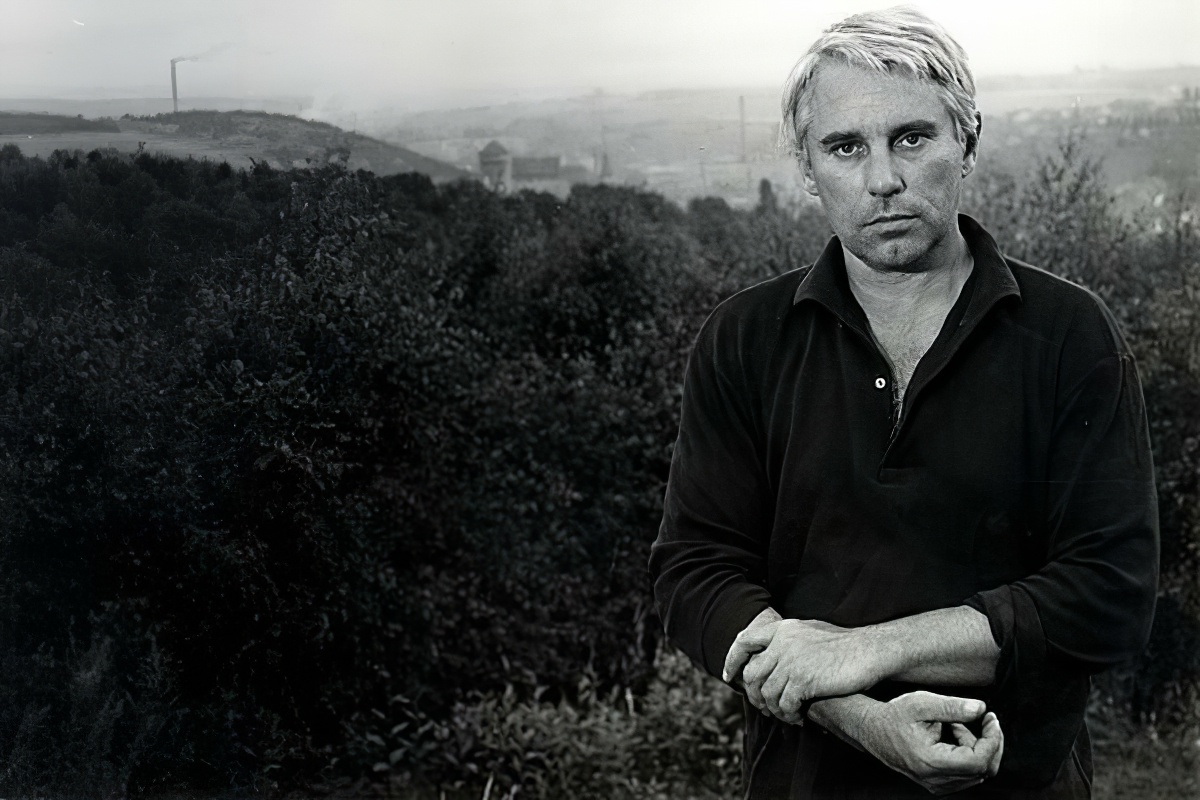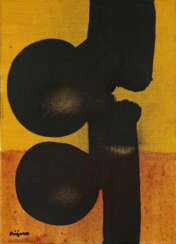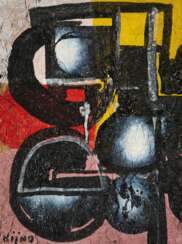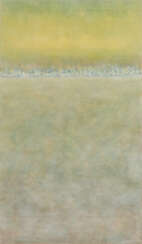
A1185: From a Magnificent Private Collection

Ladislas Kijno is a French artist of Polish origin, one of the greatest abstractionists of the twentieth century.
In 1958 he moved to Paris and was accepted into the Salon de Mai committee. In Paris Kijno invented the technique of froissage - work with crumpled paper. During the same period the artist began experimenting with spray can paints, thus creating a synthesis between traditional painting techniques and modern inventions. Through the use of spray cans, Ladislas Kijno became known as one of the "spiritual fathers" of French street art.
In 1980 at the Venice Biennale Kijno exhibited 30 monumental paintings in the recognizable "crumpled" technique under the general title "Theater of Neruda".

Ladislas Kijno is a French artist of Polish origin, one of the greatest abstractionists of the twentieth century.
In 1958 he moved to Paris and was accepted into the Salon de Mai committee. In Paris Kijno invented the technique of froissage - work with crumpled paper. During the same period the artist began experimenting with spray can paints, thus creating a synthesis between traditional painting techniques and modern inventions. Through the use of spray cans, Ladislas Kijno became known as one of the "spiritual fathers" of French street art.
In 1980 at the Venice Biennale Kijno exhibited 30 monumental paintings in the recognizable "crumpled" technique under the general title "Theater of Neruda".

Ladislas Kijno is a French artist of Polish origin, one of the greatest abstractionists of the twentieth century.
In 1958 he moved to Paris and was accepted into the Salon de Mai committee. In Paris Kijno invented the technique of froissage - work with crumpled paper. During the same period the artist began experimenting with spray can paints, thus creating a synthesis between traditional painting techniques and modern inventions. Through the use of spray cans, Ladislas Kijno became known as one of the "spiritual fathers" of French street art.
In 1980 at the Venice Biennale Kijno exhibited 30 monumental paintings in the recognizable "crumpled" technique under the general title "Theater of Neruda".

Ladislas Kijno is a French artist of Polish origin, one of the greatest abstractionists of the twentieth century.
In 1958 he moved to Paris and was accepted into the Salon de Mai committee. In Paris Kijno invented the technique of froissage - work with crumpled paper. During the same period the artist began experimenting with spray can paints, thus creating a synthesis between traditional painting techniques and modern inventions. Through the use of spray cans, Ladislas Kijno became known as one of the "spiritual fathers" of French street art.
In 1980 at the Venice Biennale Kijno exhibited 30 monumental paintings in the recognizable "crumpled" technique under the general title "Theater of Neruda".

Ladislas Kijno is a French artist of Polish origin, one of the greatest abstractionists of the twentieth century.
In 1958 he moved to Paris and was accepted into the Salon de Mai committee. In Paris Kijno invented the technique of froissage - work with crumpled paper. During the same period the artist began experimenting with spray can paints, thus creating a synthesis between traditional painting techniques and modern inventions. Through the use of spray cans, Ladislas Kijno became known as one of the "spiritual fathers" of French street art.
In 1980 at the Venice Biennale Kijno exhibited 30 monumental paintings in the recognizable "crumpled" technique under the general title "Theater of Neruda".

Ladislas Kijno is a French artist of Polish origin, one of the greatest abstractionists of the twentieth century.
In 1958 he moved to Paris and was accepted into the Salon de Mai committee. In Paris Kijno invented the technique of froissage - work with crumpled paper. During the same period the artist began experimenting with spray can paints, thus creating a synthesis between traditional painting techniques and modern inventions. Through the use of spray cans, Ladislas Kijno became known as one of the "spiritual fathers" of French street art.
In 1980 at the Venice Biennale Kijno exhibited 30 monumental paintings in the recognizable "crumpled" technique under the general title "Theater of Neruda".

Gotthard Graubner was a German abstract painter associated with the post-war Zero and Informel movements. Graubner's work is known for its focus on color and its relationship to space and perception.
Graubner studied at the Kunstakademie Düsseldorf under the painter Georg Meistermann. In the 1950s, he became associated with the Zero group, a movement of artists who sought to create a new art form that was free of traditional artistic conventions and focused on the use of unconventional materials.
In the 1960s, Graubner began creating his signature "color-space bodies," large canvases that were mounted away from the wall and filled with thick layers of pigment. These works were designed to be experienced as three-dimensional objects that were both paintings and sculptures, and they often created a sense of depth and spatial ambiguity.
Graubner's work was exhibited widely in Europe and the United States, and he was the recipient of numerous awards and honors throughout his career. He also taught at several art schools, including the Kunstakademie Düsseldorf and the Städelschule in Frankfurt.
Graubner's innovative approach to painting and his exploration of the relationship between color, space, and perception continue to be an important influence on contemporary art.

Karl Fred Dahmen is a German artist, one of the most important representatives of German post-war art and the Informel movement. In 1967 he took up the post of Professor of Fine Arts at the Munich Academy.
He painted expressive abstract pictures with a tectonic structure, and since the mid-1950s, relief paintings and collages on the damage to the local landscape caused by open-pit mining. Later in Dahmen's oeuvre, glazed object boxes appear, recounting the impressions of his daily working life.

Johnny Friedlaender was a leading German/French 20th-century artist, whose works have been exhibited in Germany, France, Netherlands, Italy, Japan and the United States. He has been influential upon other notable artists, who were students in his Paris gallery. His preferred medium of aquatint etching is a technically difficult artistic process, of which Friedlaender has been a pioneer.

Ulrich Erben is a German painter. From 1980 to 2005, he was a Professor of Painting at the Kunstakademie Münster (University of Fine Arts Münster). He is known as a master of the color field style of abstract painting, closely related to abstract expressionism, in which he creates tension between a defined surface structure, his own method of applying paint to a canvas, and the relationship of various shades of white or color to each other in their placement as part of a composition on the flat plane of a canvas. In 1986 and 2008, he was awarded the Konrad-von-Soest Prize for Visual Arts by the Landschaftsverband Westfalen-Lippe (Landscape Society Westphalia-Lippe).

Alfred Manessier was a French painter and graphic artist, a representative of the New Paris School and the Salon de May.
He was educated at the Ecole Nationale Supérieure des Beaux-Arts in Paris and was fascinated by Cubism, Surrealism, Fauvism, like many artists of that generation. But at the same time he studied with the old masters and with the coryphaei of Impressionism. In the middle of his life, Manassier reconsidered his views and turned to religious subjects and landscapes with sea views. He became involved in stained glass and tapestry art.



































































